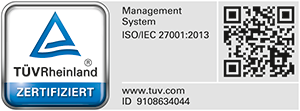![[Translate to Englisch:] Softwareentwicklung - doubleSlash [Translate to Englisch:] Softwareentwicklung - doubleSlash](/fileadmin/_processed_/6/0/csm_software-factory_keyvisual_doubleslash_925cc19c22.png)
Software Design & Software Architecture
Sustainable software needs a solid foundation – the software design
Poor software design can lead to disaster, particularly when an IT system is confronted with new or constantly changing requirements. In such scenarios, a lack of maintainability can result in soaring costs and long lead times in terms of implementing the new or changed requirements. In today’s rapidly evolving landscape, where customer needs and market trends are increasingly dynamic, this can put companies at a strategic disadvantage in comparison to their competitors.
What’s more, security incidents and software performance issues can often be traced back to deficiencies in the architecture of the IT system.

Your benefits through sustainable software design
Robust and professional software design is the basis for developing a sustainable software solution. The IT design defines the architecture of the software solution, how the solution is integrated into an existing IT infrastructure, and which specific technologies are used for implementation.
Good software design brings significant benefits not just during a project, but also throughout the entire software life cycle:
- Reduction of software complexity through transparent presentation of the software solution and its interfaces to the existing IT infrastructure. This minimises the occurrence of architectural errors, which often require correction retroactively at a high cost.
- Sustainable reduction of maintenance costs through consistent software design, especially when making adjustments in response to new or changing requirements and specifications. This ensures that your software solution is future-proof.
- Full flexibility in your IT infrastructure through robust and verifiable architectural decision-making.
- Compliance with security standards across every layer of the software architecture. This mitigates the risk of security incidents and any potential reputational or financial damage.
- Enhanced investment security and minimal follow-up costs through our certified IT expertise.
Software design in two phases: Software architecture vs. technical design
IT design can essentially be divided into two basic phases. The initial phase involves defining the IT architecture, followed by determining the concrete technical design in the second phase.
IT architecture
The IT architecture defines the essential subsystems and components that make up the IT system, that is, the fundamental structure of the IT system. The IT architecture can be designed largely independently of the specific technologies used. Initially, the emphasis is on creating a structure that optimally covers the requirements. In addition to non-functional requirements (such as maintainability and extensibility), Enterprise Architecture Management specifications also play a pivotal role in ensuring seamless integration with other systems within the company.
Contemporary architectural styles such as microservices have proven highly effective in numerous projects which we’ve undertaken with our customers.
Visual representations have become well established in the realm of IT architecture specification. We predominantly use the Unified Modeling Language (UML) for IT architecture, a powerful notation system offering various diagram types which provide distinct perspectives on the IT system.
These different perspectives allow us to illuminate all aspects of the system and reflect the varying viewpoints of the stakeholders. Below is a selection of UML diagram types which are regularly used in our projects:
Entity-relationship model
An ER diagram represents the structure of the database and how the different entities are related to each other. Additionally, an ER model serves as a built-in glossary, preventing any potential ambiguity in terminology.
Functional model
The functional model describes the components that make up an IT system and the interfaces through which these components communicate.
Sequence diagram
The sequence diagram represents the communication processes between the components.
Technical Design
The technical design determines which specific technologies are used to implement the IT architecture.
Modern frontend development often uses a JavaScript framework such as Angular, while Java or .NET are popular choices for backend implementations.
Other key decisions in software design pertain to the organisation of data in the IT system's databases and the distribution of components across the technical infrastructure. Last but not least, meticulous technical implementation of the interfaces is crucial and often demands a great deal of tedious effort and attention.
We’ll be happy to support you in professional software design!
With the right methodology and the right software architecture experts, we’ll guide your project to success together. Get in touch!


